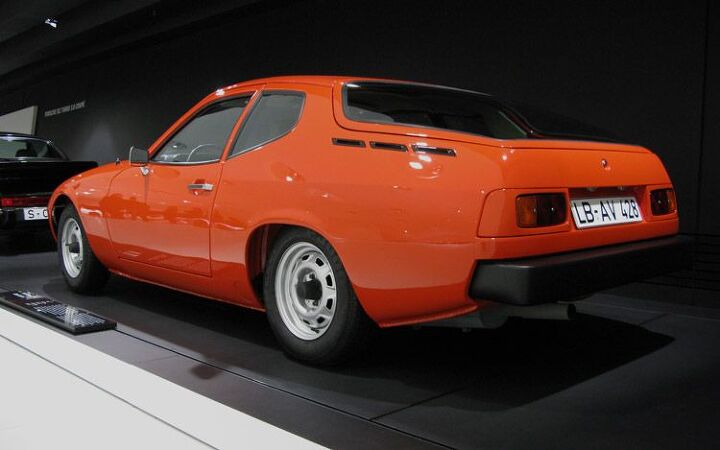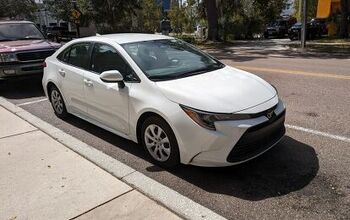Porsche's Deadly Sin #5: Engineering Project EA-425

As established in a previous article, the Volkswagen-Porsche 914 was rather more profitable for Volkswagen than it was for Porsche. No wonder, then, that VW was anxious to repeat the experience. This time, Porsche was explicitly hired as the engineering subcontractor, and the end product was meant to be badged solely as a Volkswagen. The result was what you see above: “EA 425”, a front-engine sporting hatchback using the four-cylinder water-cooled engine from the Audi sedans (and, infamously, the Volkswagen LT van).
The energy crisis made VW reconsider the production of a rear-wheel-drive sporting car. The bigwigs decided to produce the Scirocco instead. At that point, somebody had the bright idea: Hey, let’s sell the project back to Porsche and build the cars for them! Cue the ominous music…
Was the resulting Porsche, badged “924”, a true Porsche? That’s a debate which has raged for thirty-five years now, and both sides have a few points to make. It was engineered by Porsche, yes; on the other hand, the “engineering” was in large part a reshuffling of existing VW Group components, from the engine to the front suspension, which uses the lower control arms from a Mk1 Golf/Rabbit.
The 924 and its descendants were mostly assembled by Audi at Neckarsulm. Not until the arrival of the 924-based 968, twenty years later, did production shift entirely to Porsche in Stuttgart. To some degree, the 924 and its successor, the 944, are Audis — a point made again and again at Porsche Club of America events.
The Euro-market 924 wasn’t a bad steer, weighing about 2600 pounds and extracting 125 horsepower from the Audi four. The power-to-weight ratio was about the same as what we get from the US-market 2011 Fiesta, which isn’t explicitly underpowered. Unfortunately, when the 924 crossed the ocean it picked up a few hundred pounds and dropped to 95 horsepower (110 from the second year of production onwards). As a result, the proud new owner of a Americanized 924 was likely to get smoked at traffic lights by everything from the Datsun 240Z to the Chrysler Cordoba.
The 924 was a relatively reliable car by the standards of the era, but it simply wasn’t close to being fast enough. Porschephiles don’t require that their cars be the fastest ones out there, but they do need to be able to drive away from everyday family sedans, a task the 924 simply couldn’t accomplish.
Inside and out, the 924 was too obviously Audi-esque, a situation made no better by the decision to market Porsches and Audis through a common American dealer body in the Seventies. Anybody who sat in an Audi 4000 and then walked across the showroom to a 924 could plainly see that the two cars had more in common with each other than they did with the air-cooled 911 Targa sitting next to them. Furthermore, when Audi brought out the 5000 Turbo it was easily capable of smoking a 924… for less money. This was a bad state of affairs,
I will spare TTAC readers the usual rant about Porsche treating its American customer base like a bunch of ignorant dummkopfs, since you all get the picture by now, right? Only Porsche could expect to sell a car this slow for this much money ($9,395, at a time when the Corvette based at $8647.00) and only Porsche buyers would line up to buy it. Speaking as someone who was alive and enthusiastic about cars when the 924 debuted, I can attest that 924 buyers were really simply affirming their allegiance to the almighty 911 with their purchases. Nobody really wanted a 924; they wanted a Porsche. Unfortunately for them, the 911 started at $15,200 and had a habit of grenading its engine.
Porsche moved quickly to address complaints about the 924’s performance… not by fixing the 924’s performance, but by introducing a more expensive Turbo model. Let me state for the record that I adore the 924 Turbo. I think it looks fabulous and I really wish I’d purchased one when I had the chance instead of buying my 944. Still, the 924 Turbo was expensive ($20,875 on its debut, when a Corvette cost $13,140) and unreliable compared to plain-Jane 924s and it never sold terribly well. On the plus side, it was awfully hard to catch on the roads of the late Seventies, and it made for a really nice SCCA racer.
I’ve read, and have been told, a few different theories on what the 924 did for Porsche’s bottom line. Some commentators have stated that it was profitable; others, such as Karl Ludwigsen, have noted that VW/Audi extracted a very high price for the production and assembly of the cars.
Regardless of profitability, the 924 did lasting damage to the Porsche brand. It helped perpetuate the idea that there are “real” Porsches and “fake” ones and that the almighty 911 is the only true path to Porsche ownership. The dismissive way in which Toyota Corolla owners speak of Boxster drivers on the Internet is proof of this. No other successful car company deliberately sells cars which don’t quite offer legitimate entry into the owner community. We don’t think of Ferrari 458 Italia owners as somehow being second-class citizens compared to 599 Fiorano people, and the Lexus ES owner sips the same free coffee as the LS owner, but in Porsche-land there are two distinct classes of citizen. It’s been that way since the 914 replaced the 912, and it continues today. You might even argue that nowadays we have three classes of owners: real Porsche people (911), wannabes (Boxster/Cayman), and utter idiots (Cayenne/Panamera).
In the United States, the 924 was replaced by the Porsche-engined 944 and 924S, but in Europe it hung around until 1986 or thereabouts, providing an economical, inoffensive reason to wear expensive, offensive Porsche-brand clothing. I think that a base 924, without spoilers or flared fenders, actually looks fairly modern on the streets today. It was an attractively styled car, and it was a nice car… but it was never really a Porsche.

More by Jack Baruth
Latest Car Reviews
Read moreLatest Product Reviews
Read moreRecent Comments
- ToolGuy First picture: I realize that opinions vary on the height of modern trucks, but that entry door on the building is 80 inches tall and hits just below the headlights. Does anyone really believe this is reasonable?Second picture: I do not believe that is a good parking spot to be able to access the bed storage. More specifically, how do you plan to unload topsoil with the truck parked like that? Maybe you kids are taller than me.
- ToolGuy The other day I attempted to check the engine oil in one of my old embarrassing vehicles and I guess the red shop towel I used wasn't genuine Snap-on (lots of counterfeits floating around) plus my driveway isn't completely level and long story short, the engine seized 3 minutes later.No more used cars for me, and nothing but dealer service from here on in (the journalists were right).
- Doughboy Wow, Merc knocks it out of the park with their naming convention… again. /s
- Doughboy I’ve seen car bras before, but never car beards. ZZ Top would be proud.
- Bkojote Allright, actual person who knows trucks here, the article gets it a bit wrong.First off, the Maverick is not at all comparable to a Tacoma just because they're both Hybrids. Or lemme be blunt, the butch-est non-hybrid Maverick Tremor is suitable for 2/10 difficulty trails, a Trailhunter is for about 5/10 or maybe 6/10, just about the upper end of any stock vehicle you're buying from the factory. Aside from a Sasquatch Bronco or Rubicon Jeep Wrangler you're looking at something you're towing back if you want more capability (or perhaps something you /wish/ you were towing back.)Now, where the real world difference should play out is on the trail, where a lot of low speed crawling usually saps efficiency, especially when loaded to the gills. Real world MPG from a 4Runner is about 12-13mpg, So if this loaded-with-overlander-catalog Trailhunter is still pulling in the 20's - or even 18-19, that's a massive improvement.





































Comments
Join the conversation
I'm not sure that I agree about this being a sin. Every car from Porsche can't be perfect, and I think the positive testimonials + enduring appeal of these little buggers makes up for them being slow + overpriced upon release. Let's not forget that when this came out the Corvette was probably in its darkest days, with its base model weighing in at 3700 lbs, punishing a choked up 350 that could only muster 180 HP. So while the Vette may have had a marginally better power to weight ratio, it was still a dog, with significantly worse gas mileage, build quality, ride quality, handling & IMO a garish + cartoony design. Thinking about it now, aside from the RX-7, which was still a 2 seater with its own issues, and the E21/E30 3's, I can't think of a car from the 70s that offered the same amount of practicality with such a quality driving experience (outside of the slow engines, which were just a consequence of the times). Can you?